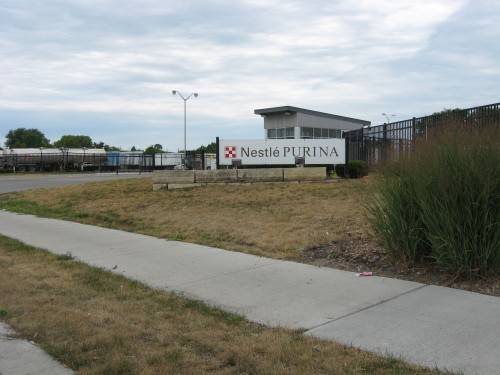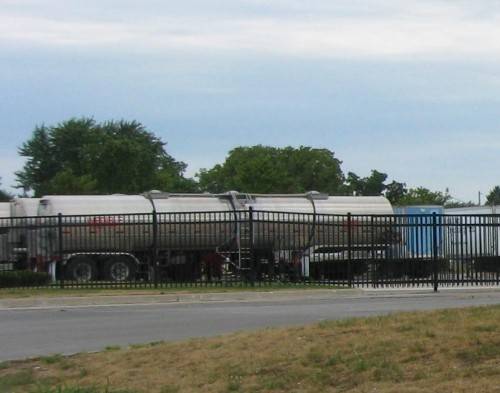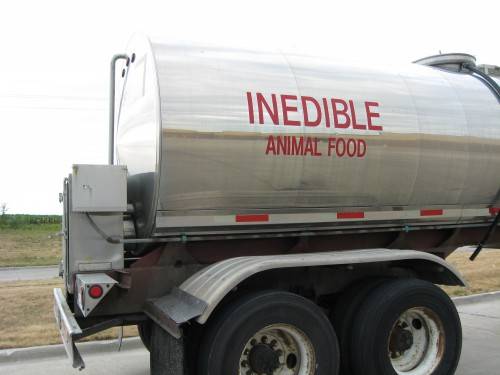Hold on to your hats! 
I watched the program “Dirty Jobs” …… “Inside A Rendering Plant”
again last week and was reminded of the filth that some of these pet
food companies feed to our furry kids. The “Dead Truck” driver in the
segment said that there are only a couple “Dead Trucks” in CA (where
this one was filmed) to make the rounds to ALL of the farms that have
dead animals to pick up. He said, some of these cows and horses lay
in the sun for 6 days or more before they pick up the bloated, rotten,
maggot ridden bodies and transport them to the rendering plants. By the
way….no one was asking WHY the animal died! Old
age?….Disease?…….Euthanized???? (sodium pentobarbital does not dissipate
in the cooking process) He told the interviewer that they have to be
careful not to let the animal “Explode” on them while chaining up the
legs to be dragged up into the semi’s!!!! This driver also revealed
that these bodies are delivered to different rendering companies that process them into pet food,
chicken feed and fertilizer. This is what goes on all over the
country! And it’s not just limited to farm animals! Euthanized
companion pets from the shelter’s get picked up too! (I also have a
movie showing this.) There are 3 to 4 million pets euthanized per year
and they certainly don’t bury or burn them! Too costly!
This program took us inside the rendering plant showing dirty, rusty
machines that grind up the animals and cook them before the mix is
delivered to the dog food manufacturing plants, which turns this mess
into kibble. This was SO unsettling to watch! By the way, the rendering
company in this story was the only one they could find that would let
them inside to film! Not something the pet food companies want
publicized!
Disgusting what the FDA allows in pet food and sells it to the
unsuspecting pet parent who thinks that pristine whole chickens and
beautiful crisp fresh vegetables fall from the sky into these bags!!!
THEN, yesterday, I saw this article by Susan Thixton and was again
infuriated and thought you might be interested in seeing what sits
outside most dog food plants…..In this case Purina’s!
These telling picture’s are thanks to a concerned pet parent that
happened to be in Fort Dodge Iowa where one of the the Purina Plant’s is
located.
“Inedible Animal Food” at the Purina Plant


If you look at this image closely, you’ll see tanker trucks parked inside the Purina plant property…

And just this section of the above image made larger…you can read “Inedible” on the tanker…

But this wonderful pet owner – that provided these pictures – didn’t
want others to miss what was stated on that tanker truck. So she took a
close up of the tanker itself (that was parked inside Purina property)…

Yes. “Inedible Animal Food” inside a pet food plant.
So what is “inedible animal food”?
Within U.S. federal regulations, there is no definition of ‘inedible
animal food’. Basically, inedible animal food is ‘inedible’ for human
consumption foods. The Code of Federal Regulations (CFR) defines ‘inedible’ as: “Adulterated, uninspected, or not intended for use as human food.”
Canadian regulations state “Inedible
products include products which are, by their very nature, inedible
(i.e. feathers, hides, hair), condemned, “previously edible” materials
which have been condemned, and specified risk material (SRM) which
includes recovered solids from waste water, on their premises, as
prescribed in Section 28…”
To give a little more insight into exactly what ‘inedible animal food’ could include, the (U.S.) Code of Federal Regulations (CFR 314.10) titled “Livers
condemned because of parasitic infestation and for other causes;
conditions for disposal for purposes other than human food” states (bold added):
“(b) Livers condemned because of parasites other than hydatid
cysts; and livers condemned because of telangiectasis, angioma,
“sawdust” condition, cirrhosis, carotenosis, or other nonmalignant
change, benign abscesses, or contamination,…may be shipped from an
official establishment only for purposes other than human food…”
“(c) Livers condemned because of conditions described in paragraph (b) of this section shall be in containers plainly marked “inedible”.”
And federal law
is concerned with the risks associated with ‘inedible products’. The
law is clear no diseased animal or diseased animal tissue (inedible)
should come in contact with USDA inspected and approved products. “Handling and Disposal of Condemned or other Inedible Products at Official Establishments” (Title 9, Part 314.8 b Dead animal carcasses)…
“Under no circumstances shall the carcasses of any animal which
has died otherwise than by slaughter, or any part thereof, be brought
into any room or compartment in which any edible product is prepared,
handled, or stored.”
To be fair, all ‘inedible’ products are not diseased animal parts.
Parts of a slaughtered animal that are not commonly consumed by humans –
such as internal organs (but including intestines) could also be
considered inedible. But significantly important, federal regulations do not require these types of inedible products to be “plainly marked inedible”. Only diseased animals or filth contaminated products must be “plainly marked inedible”.
‘Inedible’ products can be shipped directly to pet food manufacturers
or these products can be sent to rendering facilities to be processed
into various pet food ingredients. There are federal regulations governing the transportation of this material as well. “325.11 Inedible articles: denaturing and other means of identification; exceptions” states “tank cars and trucks” containing inedible products shall be clearly marked as “inedible”.
The law even goes into great detail of how high the letters marking
‘inedible’ must be and expands into requirements to providing a clear
background behind the ‘inedible’ markings.
Yes, there are laws against the use of condemned material in pet
foods. Federal law clearly defines ‘food’ to include animal foods. Chapter 9 Federal Food, Drug, and Cosmetic Act Chapter 9 321. Definitions defines food as…(bold added)
“(f) The term “food” means (1) articles used for food or drink for man or other animals, (2) chewing gum, and (3) articles used for components of any such article.”
And federal law defines an adulterated food (and thus prohibited) Chapter 9 – 342. Adulterated food: “if it is, in whole or in part, the product of a diseased animal or of an animal which has died otherwise than by slaughter.”
Inedible is a violation of federal law in all foods – human or animal.
Why isn’t federal law being enforced with pet foods? Why are
“inedible animal foods” allowed to be processed into pet foods without
the very same clear marking – the required Inedible marking- on the pet food packaging?
Pet food consumers deserve to be informed of what they are
purchasing. If ANY ingredient within that food or treat was required to
bear the Inedible marking, the pet food/treat should bear the same Inedible marking. The law is the law…except with pet food.
Related posts:
- PLEASE Help!
- Wellness Dog Food Recall
- Oma Food
- Honest Kitchen Dog Food
- Innova and California Natural